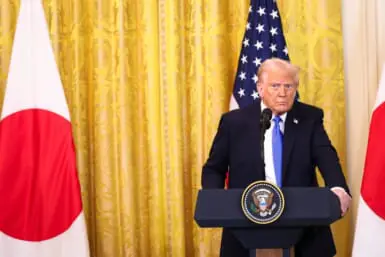by Elyse M. Rogers
RANDALL SAKAMOTO, O.D.
Readers often ask for the names of American doctors and health professionals in Japan, and then I must explain the unhappy problems of health professionals practicing here and why we have so few. But happily, today I can recommend an American health professional, a Doctor of Optometry, who is practicing in Japan right close by at the Tokyo Medical Surgical Clinic. Here’s a doctor who speaks “native English” and is a well-qualified and caring professional as well.
I’ve explained in the past that the clinic has, in addition to the five physicians in daily practice, a host of specialists on call. Many of the specialists come into the clinic on a weekly basis to serve the needs of clinic patients who need care in their particular specialty. And, such is the case with Dr. Randall Sakamoto, who comes to Tokyo from Nagoya on Saturday mornings to do full eye examinations and give the appropriate prescriptions for eyeglasses or contact lenses.
BACKGROUND ON DR. SAKAMOTO
First let me explain that there are two Dr. Sakamotos at the Tokyo Medical Surgical Clinic, so if you are interested in an eye examination, be sure you specify Dr. Randall Sakamoto. (Otherwise you’ll get the Dr. Sakamoto who does obstetrics and gynecology; that may not be too bad if you’re a woman of child-bearing age. but might be a bit disconcerting for men.)
Dr. Randall Sakamoto is an American (nisei) who grew up in Chicago under the watchful eye (couldn’t resist the pun) of his optometrist father. He was graduated from the University of Michigan as an undergraduate, and then decided to follow in his father’s footsteps and become an optometrist. For this purpose he attended the Illinois College of Optometry in Chicago, (one of only approximately 15 schools in the U.S.) and after completing the four-year program he graduated in 1981.
After graduation he spent a year practicing with his father in Chicago, and then went on to Honolulu where he practiced for three years. Another year in practice in the Bay Area of California and then it was on to Japan. When I asked him why he came to Japan he said he’d always been interested in the country and finally decided to relocate here. He’s very much enjoyed his two years in Japan, and hopes to expand his practice in this country.
DEFINING ‘EYE DOCTORS’
Getting different eye doctors straight can be a bit confusing, so let me explain the different types of terms we use in the United States.
- Optometrist. An optometrist is a person who has completed a four-year (post college; doctorate program in optometry. After taking a licensing examination, that person is a doctor of optometry, and can put the initials O.D. after his/her name. There are currently about 23,000 optometrists in the U.S. According to Dr. Sakamoto (who is an O.D.) optometrists are considered “primary eye care doctors.” For example, they do over 60% of all eye examinations. In addition to full scale eye examinations, they do glaucoma testing, check the total health of the eyes, and prescribe glasses or contact lenses.
- Ophthalmologist. An ophthalmologist is a medical doctor, who completes the four year medical-school program, lakes the licensing medical examination and can use the initials M.D. after successful completion of that exam. Then, that doctor goes on to additional training (usually for three years) to become a specialist on eye conditions and eye surgery.
- Optician. An optician is a person who has taken a course in fitting and preparing glasses and contact lenses. He/she often is a college graduate, but does not necessarily have to be one.
Although optometrists are not a recognized specialty in Japan, at the Tokyo Medical Surgical Clinic Dr. Sakamoto is able to deliver the full-service type of optometric examinations that we Americans and other nationalities are used to. The doctor says that eye examinations arc extremely important, not only for those who wear glasses or are having trouble with their vision.
“The eye is very much a mirror of the body,” he tells us. “When we look into the eye with an ophthalmoscope we can view directly a nerve that is directly connected with the brain—it’s the only place in the body where such a nerve is visible. As a result of observing any vascular changes in the nerve we can diagnose or suspect diseases such as diabetes, brain tumors, high blood pressure, etc.”
In addition, eye problems such as glaucoma and corneal ulcer can be identified during an eye exam. If disease conditions are identified or suspected, the patient will be referred either to the family medical doctor or to an ophthalmologist. Dr. Miyajima is the ophthalmologist at the clinic, so quick follow-up or more advanced consultation is easy.
THE THREE WORLDS OF DR. SAKAMOTO
I should mention that when Dr. Sakamoto is not attending to eye examinations in Tokyo, he is busy pursuing two other jobs, which are as follows:
1) Clinical Consultant to Medicon Contact Lens company. With Medicon he is working on new lenses. For example, in the case of a disease called caratocosis, the cornea becomes cone shaped (instead of round) so that vision becomes distorted. Although there are lenses to aid vision in these cases, there are problems with fitting the lenses because of the cone-shaped cornea. So, Dr. Sakamoto and others are working on designing a lens with a better fit.
2) Researcher at Tokyo Women’s Medical College. At this medical college he is working with new types of contact lenses which arc currently in the process of being approved for use in this country.
So, the doctor has a three-way career, which certainly keeps him busy. However, he confesses that clinical practice, or the work he docs at the Tokyo Medical Surgical Clinic with all of us ex-pat types is the favorite part of his weekly work.
CONTACT LENSES
Since I’ve had many requests for information on where and how to get contact lenses (or get reexamined for those who already have such lenses), this was a subject I was particularly eager to discuss with Dr. Sakamoto. Many of you may know a great deal about contact lenses, but for those of you who don’t, some of the facts that I learned from the good doctor may be of interest:
- The most important physical attribute of a good contact lens is its ability to “breathe” or allow oxygen to get to the eye. Currently the rigid gaspermeable lenses are the best in this category.
- With the improved contact lenses available, almost everyone today who wants or needs contact lenses can be properly fitted with them.
- The biggest reason for contact lens problems is “lack of compliance,” which means that those who wear them don’t take proper care of them. Dr. Sakamoto says that it’s estimated that over 50% of contact lens wearers do not use and care for their lenses properly. Since only certain kinds of solutions can be used on certain types of lens systems, for example; it’s important to know and use only the right solutions.
- The ”extended wear” contacts that we’ve all read a great deal about have recently gone out of favor a bit due to some rare infection problems. The “daily wear” contacts are more popular.
GETTING CONTACTS
If you’re one of those who would like contact lenses or need new ones, you may be interested in knowing the system at Tokyo Medical Surgical Clinic under Dr. Sakamoto.
1) Make an appointment and go through the routine “full eye examination.”
2) Depending on the results of the eye examination, glasses or contacts will be prescribed.
3) Take your prescription for the glasses or lenses to either a local megane-ya (eyeglass store), or go on Saturday afternoon to the Ginza “eye boutique” where Dr. Sakamoto is on duty from 3 to 6 p.m. to select glasses or get fitted for the contact lenses.
4) If you go to Dr. Sakamoto’s “eye boutique,” you should return the following week to get your glasses or contacts. At that time he will make sure they fit properly and instruct you on the proper use and care of your contacts.
5) Return for follow up visits to the Tokyo Medical Surgical Clinic. Dr. Sakamoto’s schedule for new patients with contacts is as follows: return visits after one week, two weeks, one month, three months and six months. And he prefers his patients to come in for a quick check every six months thereafter.
Even though Dr. Sakamoto is in Nagoya for most of the week, he is easily available by phone. He gives his patients his phone number and encourages them to call him directly if they have any questions or problems. (He has an answering machine, too, so even if he’s not there he will get back to the patient soon.)
OFFICE HOURS, APPOINTMENTS & FEES
From 9 a.m. to 1 p.m. on Saturdays is when Dr. Sakamoto is at the Tokyo Medical Surgical Clinic. Appointments must be set up in advance by calling the regular clinic number (see end of column).
The “full eye examination” takes approximately 20 minutes and costs ¥9,000. The prices of contact lenses and glasses will vary depending on where you get them and what type you need or choose, but some ballpark figures might be helpful: a) eyeglasses from ¥15,000 to ¥30,000 (or more if you want 14ct gold frames or such), and b) contacts from ¥25,000 to ¥50,000. These prices are probably a bit more expensive than in many of your home countries, but then what isn’t more expensive in Japan?
Randall Sakamoto, O.D., Tokyo Medical Surgical Clinic, Mori Bldg 32 (2F1), 3-4-30 Shiba Koen, Minato-ku, Tokyo 105. Phone 436-3028.








